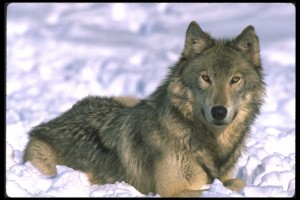Wolves are the largest members of the canid family (dogs) in North America. They once roamed throughout Cascadia, but now are absent or greatly reduced through most of their historic range. Wolves are recovering in Oregon and Washington. OR-7, affectionately know as Journey to some, traveled from northeastern Oregon and down the Cascades to visit California, reinforcing the fact that viable wolf habitat remains in the state. And the wolves in Alaska are heavily hunted and trapped which is a constant concern with the most vulnerable population being the Alexander Archipelago wolves that live on the southern islands of the Tongass National Forest in southeastern Alaska. These latter wolves are deer specialists and reckless clearcutting plans with the associated roads are putting their subspecies at great risk (see wolf section of website for greater detail on species and their value to ecosystems).
Coyotes are less than half the size of the average wolf and occupy nearly all of Cascadia. Coyotes are food and habitat generalists and more tolerant than wolves of settled areas, roads and humans. Ecologically they — like wolves — are a largely misunderstood animal. Some ranchers and hunters tend to focus on their negative impacts to livestock and game animals without understanding their role in rodent control and impact on other species within their home ranges. Anti-coyote constituencies typically believe that control of these animals has benefit without understanding that they may be doing more harm that good when they open occupied and defended territories or create room for reproductive responses — and the need to feed pups — just when lambs are born or calves are dropped. Human pressure on coyotes through trapping, shooting and poisoning is intense and often cruel is some areas.
Gray fox
The gray fox is the dominant fox in Cascadia south of the Canadian border and can be identified by its gray color and black tipped tail. The general rule for gray fox versus red fox distribution prior to European colonization of North America was for gray foxes to use deciduous forests and red foxes to inhabit boreal or northern forests. This changed when developed areas increased as red foxes are more tolerant of human occupation and disturbance. Gray foxes are also tree climbers and often den above the ground in hollow trees. Gray fox populations are generally in good shape in areas with intact habitat and low levels of human disturbance.
There are multiple red fox subspecies in Cascadia which is the cause of some confusion and impact. The most critical red fox subspecies is a native and is one of the most endangered mammal species in North America with a total population of around 50 individuals — mainly at altitudes above 4,500 feet in California. This fox is known alternatively as the Sierra Nevada red fox or the High Sierra fox, but a remnant population may also exist in Oregon in the Mt. Hood Forest and elsewhere at high elevations south of the Columbia River.
There is also a non-native red fox introduced from the East that is causing problems in some areas for native birds that did not co-evolve with this fox or its cat-like hunting behavior. This alien species is also responsible for some range reduction in native red fox subspecies which are genetically similar but behave differently after being geographically separated for nearly 10,000 years.
Recent posts on this topic:

